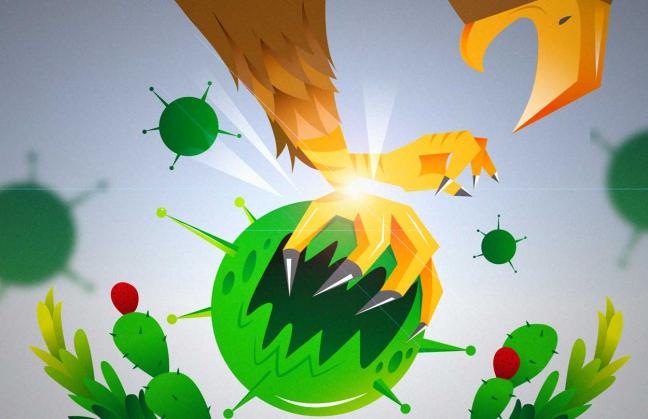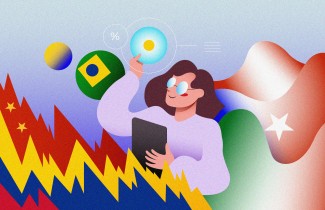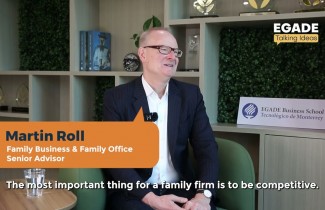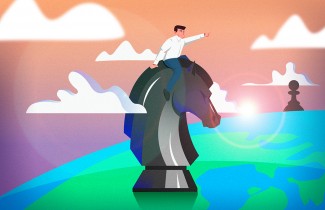Lessons from Scenarios to Address COVID-19 in Mexico
We can learn from scenarios how to address COVID-19 and other catastrophic events, building a more just and sustainable future

We live today in an era of what we might call “foreseeable unexpected events.” COVID-19 is one such event. It was foreseeable (and foreseen) but its timing and manifestation were unexpected. Scientists also warn us of the impacts of climate change, but as in the case of pandemics, we are surprised by and unprepared for severe climatic events that we know are increasingly likely.
What we have learned from applying scenarios to strategic planning can help us respond as individuals, firms and society to the COVID-19 pandemic as well as other “foreseen unexpected” events. We can also learn from this experience how to create a better, more just, and sustainable future. In the study, Mexico Facing the Future, (Woodrow Wilson Institute, Mexico Institute, 2019) we reported on a series of scenario planning exercises undertaken with firms, Mexico’s Business Coordinating Council (Consejo Coordinador Empresarial), public agencies and students at the EGADE Business School, In a previous article, we described four categories of strategic actions that we can use as firms and as societies to prepare for an uncertain world. The focus of the previous article was on structural, systemic change such as the emergence of new technologies under the 4th Industrial Revolution. This article examines how these same four strategy categories provide guidelines to focus on and learn from COVID-19.
At the moment we might believe that Mexico will not suffer the most severe impacts of COVID-19 that Italy has suffered, that it will receive a dispensation escaping COVID-19’s most grievous consequences. Other country’s experience suggests that few are exempt, and the extent of damage depends on actions that we ourselves take. It might be comforting to think that, “this is something that happens to others.” But there are insistent realities: 1) once we know for sure we have a problem, it is too late to take action, and 2) there will be others.
We face, paradoxically, foreseeable unexpected events. We can be sure that there will be severe, unexpected pandemics, seismic events, and climatic events in the future. According to the World Health organization, just in the 21st century there have been 4 major epidemics prior to COVID-19—SARS in 2013, H1N1 in 2009, MERS in 2012 (first manifestation) and Ebola (from 2014 onward). These incidents have destroyed numerous myths: that we have the capacity to avoid them, that they are the problem of isolated communities in “other” countries and that their impacts can be readily controlled. The same can be said of climatic events.
We will have to adapt with compassion toward others, in particular the most marginalized members of society. The philosopher, John Rawls described a just society as one in which we would choose to live if, blinded by a veil of ignorance, we did not know what position we would occupy that society. The same principle should guide our response to COVID-19. A society demonstrates its strength when it can find Rawlsian justice not when everything goes well, but when everything goes wrong. Will we protect ourselves alone, or will we account for the most marginalized in our society?
Four strategies to address foreseeable unexpected events such as COVID-19
COVID-19 is now a fact and epidemiologists tell us it will reach us as an inevitable tsunami. With personal and societal actions, we can mitigate is impacts, but we can no longer avoid them. What can we learn from it? What can we do?
- Monitor emerging tendencies. No one expects a pilot to fly without a radar. Yet public and private institutions frequently conduct planning in a rear-view mirror without systematic thinking about the future and avoiding thinking about what is disagreeable. Epidemiologists (and climatologists) have developed sophisticated models of what might happen, but policy makers do not always listen to them. The objective can never be to predict the future but to ask ourselves, “What if?” and to adapt and renew institutions and their purposes continually.
On March 19 the New York Times published an article that summarized numerous efforts undertaken between 2009 and 2019 to learn from previous pandemics, beginning with H1N1 and Ebola. One exercise, called Crimson Contagion, undertaken between January and August 2019 anticipated that, in the event of a respiratory virus without a vaccine, there would be 7.7 million hospitalizations in the United States and 586,000 deaths. The causes were: a lack of respirators and a confused government response. The draft report of Crimson Contagion was presented in October 2019 (it appears a final report was never produced). Nevertheless, the National Security Council office charged with tracking global pandemics was eliminated. When COVID-19 appeared, at the end of 2019, the United States and other countries initially did not recognize its implications (detailed in Crimson Contagion) and a golden opportunity to anticipate and mitigate its consequences was missed.
The lesson learned is clear and has been ignored: it is important to establish institutional mechanisms with an explicit responsibility to anticipate the future, and to pay attention to them even when we do not like what they say.
- Construct resilient physical, social and institutional systems. The first consideration must be to protect the response capacity of the medical system against a demand surge that can cause it to collapse. The primary purpose of “flattening the curve” is neither to reduce the number of cases or to shorten the duration of the pandemic (indeed it may prolong the pandemic). The primary purpose is to protect the health care system from being overwhelmed. This article explains the urgency of protecting the response capacity of the healthcare system.
Most experts give priority to protecting the healthcare system above the economy. An enormous reduction in economic activity needed to protect the healthcare system will result in a weakening of the economic system. We can already see the impact on global stock markets. As the data become available, we will see the impacts on employment. A global recession appears inevitable.
After the 2008 financial crisis, the United States Federal Reserve established “stress tests” for major banks. Should companies themselves establish stress tests for “foreseeable unexpected events?” As a recent Harvard Business Review article suggests, it is plausible that a recession resulting from the COVID-19 epidemic will be followed by a relatively rapid V-shaped recovery, but longer-term, and more damaging, U or L shaped recessions are also possible. Stress tests could enable key economic actors to assess their capacity to weather future storms.
It is not a question only of health and economic systems. Social safety nets are totally inadequate to address events of this magnitude. It is a question of protecting the 60% of Mexican workers who work in the informal economy, not of protecting the elites. A colleague asked, “what happens to the guy who shines shoes?” The questions are much broader: what happens in a highly unequal society to protect those who live day-to-day? How prepared are companies to protect their employees as well as their shareholders? How are workers in new forms of work such as the gig economy affected? (The gig economy can become a creative form of employment not only for drivers but also for designers and programmers and others who fill niches in a modern economy, but to function it requires effective safety nets).
Psychological resilience is also important and includes mutual help networks. I write this from Boston where we are weeks into “social distancing.” A commentator recently stated that we need physical distancing, but we need to move closer together socially. We all need social and psychological networks even as we are physically isolated.
The lesson learned is that it is important to have medical, economic, physical and social reserves that create a resilient society. The immediate response now must (literally) be to “save the patient,” but longer term we must establish stress tests to establish whether key institutions can survive “the foreseeable unexpected.”
- Make “robust” long term investments, committing ourselves to a better future. We do not control the future, but we can make long term social and economic investments that lead us to a better future. Scenario practitioners call these “robust” investments or “no regrets strategies” because they serve us well independently of what future materializes.
Moments of crisis can be an opportunity to bring societies together, to find an inner strength and to commit ourselves to a better future. Some say the current crisis will pass in weeks; others say with greater likelihood that it will last 12-18 months. We know it will end. What society do we want to build for after the crisis? To what future should we commit ourselves today?
In Paradise Built in Hell Rebecca Solnit describes how societies have found an inner strength to recover from catastrophic events. While some have reacted selfishly, Solnit argues that the overwhelming response has been for societies to come closer together, when the better angels of our nature come forward. She describes the response to the 1985 Mexico City earthquake as follows:
“…During the 1985 Mexico City earthquake, citizens discovered each other, their own strength, and the superfluidity of what had seemed like an omnipotent and pervasive government, and they did not let go of what they discovered. It reshaped the nation. The real disaster began long before the earthquake, just as the utopia of social engagement and community strength lasted long after.
Subsequently, she quotes Judith Garcia, a survivor who lost her husband and two small children:
“I want to state that the people who died didn`t die because of the earthquake; that is a lie. People died because of poor construction, because of fraud, because of the criminal incapacity and the inefficiency of a corrupt government that does not give a damn about people living and working in buildings that can collapse…”
With the earthquake, there appeared in Mexico City a true community spirit and a strong civil society took form, focused on mutual assistance and a vision of a better future. Can the example of the response of the citizens of Mexico City to the earthquake serve as a model for us today?
There is little doubt that the current crisis will transform societies and economies. It is likely to decrease reliance on brittle global value chains. Distance shopping, work and learning are likely to become more prevalent as habits acquired in dealing with the forced isolation of the crisis become more engrained. Some of this will be positive. As we argued in a previous article, technology creates opportunities to free humans from degrading, routine work and to connect marginalized communities to broader capabilities and markets. These same technological capabilities can lead to a more fractured, less private world dominated by a few mega-corporations or governments. The challenge of the response to structural economic and technological shifts will be how to place human beings, not institutions, at their center.
Mexico’s Business Coordinating Council has proposed a Decalogue of business responsibilities. This could be a starting point for a business response, but the response must include other sectors as well. It will be important to commit to the public and private investments that will bring about a better world (these will also have a positive economic stimulus effect in overcoming the recession).
Social and economic investments in the capabilities, economies and the sectors of the future will be required. The educational system must provide students not only the hard skills (science, technology, engineering and mathematics) skills; it must also provide the soft skills that make for responsible, informed and productive members of society, including civic responsibility, empathy, teamwork, creativity and entrepreneurial spirit. It will also be important to recognize that new forms of work such as the gig economy are here to stay. They will complicate the distinction between formal and informal work, and they will require a rethinking of social safety nets. In the end, they can create more creative work options for those who can and want to use them. COVID-19 does not remove these priorities; it makes them, if anything, more important.
The lesson learned is that we can find in the COVID-19 crisis a return to the fundamental principles of a society and an economy that puts human beings and the environment at its center. We can use it as a springboard to a sustainable future for all Mexicans.
- Bet on opportunities that create a better future. Technological and structural economic changes driven by the COVID-19 crisis threaten to undermine the role of human beings in productive activities. Or, they can open new business activities in what the French author Letitia Vitaud has written about in Du Labeur a l’ouvrage, a technology-enabled transition from work to craft. Vitaud refers to new forms of work that replace dehumanizing mass production, using technology to leverage human initiative and creativity. COVID0-19 underlines the need to invest in these more resilient businesses of the future that are less vulnerable to massive disruptions.
The bulk of the investment in new business opportunities will come from firms, entrepreneurs and impact investors who are prepared to accept longer term returns in exchange for a benefit to society. Unlike robust social investments in education and social infrastructure, these private investments will involve risk (though in high risk/long return but high impact situations some form of public mitigation of risk may be justified). Firms and investors will fail and succeed. In many cases they will need to pivot to new opportunities. Ultimately, however, they will create businesses of the future that are less centered on overdependence on hyper-globalized markets.
The lesson learned is that COVID-19 accelerates structural economic and technological changes that, if handled right, can lead to a more just and more sustainable future. In doing so, it will create business investment opportunities.
In 1947 Albert Camus’ novel The Plague was published. It was situated in Oran, Algeria during a plague that decimated the city. The hero of The Plague was Dr. Bernard Rieux who identified the plague and, like the Chinese doctor, Li Wenliang who first identified the coronavirus, was ignored because it was not convenient to the authorities to take his warning seriously. Both the fictional Dr. Rieux and the real Dr. Wenliang dedicated themselves to curing plague victims, not because of an ideological belief but because, as doctors that was their job (in contrast to Panelux who saw the plague as a punishment from God). The real Dr. Wenliang lost his life curing patients. We are not all doctors, but we can learn from their example in our own work to improve the world in which we live.



